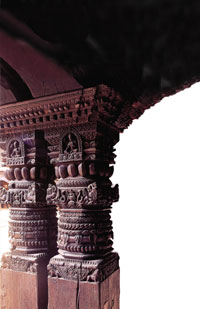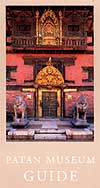 If you thought Patan Museum was great, here comes a book that is almost as exquisitely crafted as the real thing. You can tell both the book and the museum were a labour of love for the author and architect, G?tz Hagm?ller. Long-time valley resident and nearly-naturalised Nepali Austrian, he supervised the transformation of the Patan Museum from a crumbling building to a world class repository of religious artefacts.
If you thought Patan Museum was great, here comes a book that is almost as exquisitely crafted as the real thing. You can tell both the book and the museum were a labour of love for the author and architect, G?tz Hagm?ller. Long-time valley resident and nearly-naturalised Nepali Austrian, he supervised the transformation of the Patan Museum from a crumbling building to a world class repository of religious artefacts.
his is a place like no other. In which other museum in the world would you find visitors bowing to worship some of the figures on display? The elegant exhibits, the harmonious lines of the corridors blending with balconies and courtyards, the painstaking restoration of the outside, all make this museum a work of art in its own right. There are clever little touches like a wind chime that tinkles all the time over the entrance because a hidden electric fan is blowing at it, the cushioned sitting area near the windows from where Malla kings must have looked out at Krishna Mandir and their subjects, the gap between the ceiling and the wall in the display area to show the way in case the lights go off.
The displays themselves are rare and priceless treasures of Hindu, Buddhist and Tantric religious objects, some of them items that were stolen from Kathmandu and recently returned, like the 12th century Uma Maheswor sculpture brought back from a museum in Berlin two years ago. And alongside human-crafted figures are those made by god: an ammonite fossil 60 million years old which is revered because the shiny petrified remains of the spiral pre-historic mollusc looks like Ganesh's trunk.
G?tz Hagm?ller's book, Patan Museum: the Transformation of a Royal Palace in Nepal, is not one of those covers usually sold in a museum gift shop. It is more. The pages tell the dramatic story of the restoration process with many before and after illustrations, guest contributions on Kathmandu Valley, on antique thefts, and even on the architectural planning of the caf? inside the museum. It is not just a museum goer's companion, it is also a guide to the endangered heritage of Kathmandu Valley. The book's being launched on 1 December, and is being produced as part of the Patan Museum project with funding from the Austrian donors. There will be two editions, soft cover and hard cover. In addition, the Austrian government is donating 3,000 soft cover copies to the museum so the proceeds can be used by the museum. The hard cover edition is available internationally.
Available in the market already is a handier museum guidebook: Patan Museum Guide, which is a shortened version of the more expensive coffee-table book. Its Nepali translation, Patan Sangralaya, Ek Chinari will be launched on 1 December. Both are published by Patan Museum.
Hagm?ller's passion for his subject shows in the books, his careful attention to detail from the brass cire perdue museum sign to the planning of earthquake-resistant steel brackets so that it would be in harmony with the surrounding carved wooden pillars.
Hagm?ller has also taken a chapter to compare the dimensions and spaces of the Keshav Narayan Chowk complex with the Hapsburg-era National Library in his native Vienna, and the author tries to imagine the motivation of the Malla kings and the imperial Hapsburgs. He muses why people always sit on the benches outside Patan palace in the afternoon sun, and not in front of the buildings in Vienna.
Not that this Austrian connection to Nepal is anything new. In fact, it goes back to 1660 and the visit to the Valley by the Austrian Jesuit priest, Johannes Grueber. The traveller presented Pratap Malla with a telescope, a depiction of which can still be seen on a stone relief at Hanuman Dhoka where a child on the lap of the queen is peering through the eye-piece. Several centuries later, we saw the arrival of Austrians like Carl Pruscha and Eduard Sekler who cultivated a respect for the living heritage of Kathmandu Valley and shared a worry about its future.
Hagm?ller is the last in this line of illustrious Austrians passing through Nepal. He is often asked why he has decided to live and work in Kathmandu Valley. One of his answers is: "It is the semi-darkness between shadow and light that inspires."
And you can see that interplay of light and shadow in the sacred spaces of Kathmandu Valley, in the ancient palace complexes, and they have also been delicately woven into the restoration of the Keshab Narayan Chowk into a museum. When direct sunlight does come in, it is on the monochrome ochre of the brickwork and the tiles of the courtyards so that the ambience is bathed in a soothing pink afterglow.
The pages of Hagm?ller's book walk us through these courtyards and corridors of the old palace, and we are told by Usha Ramaswamy in one of the chapters of how we brush against "the hush of centuries".
Hagm?ller was helped by curator and authority on Himalayan art, Mary Slusser, who has written several chapters on why the museum was designed as it was: the debate over light and dark, over spaces and how much intervention is possible while still being honest to textures and layers of history. The project's intention was to create a museum "within the cultural context of its collection as an integral aesthetic whole". And how marvelously they succeeded in doing that.
 Patan Museum
Patan Museum
The Transformation of a Royal Palace in Nepal
G?tz Hagm?ller
Serindia Publications, 2002, London
Price: Rs 3,800 (hardback in book stores)
Rs 2,400 (soft cover only at Patan Museum)
 Patan Sangralaya
Patan Sangralaya
Ek Chinari
Patan Museum, 2002
Lalitpur
Price: Rs 300
 Patan Museum Guide
Patan Museum Guide
Patan Museum, 2002
Lalitpur
Price: Rs 1,000


